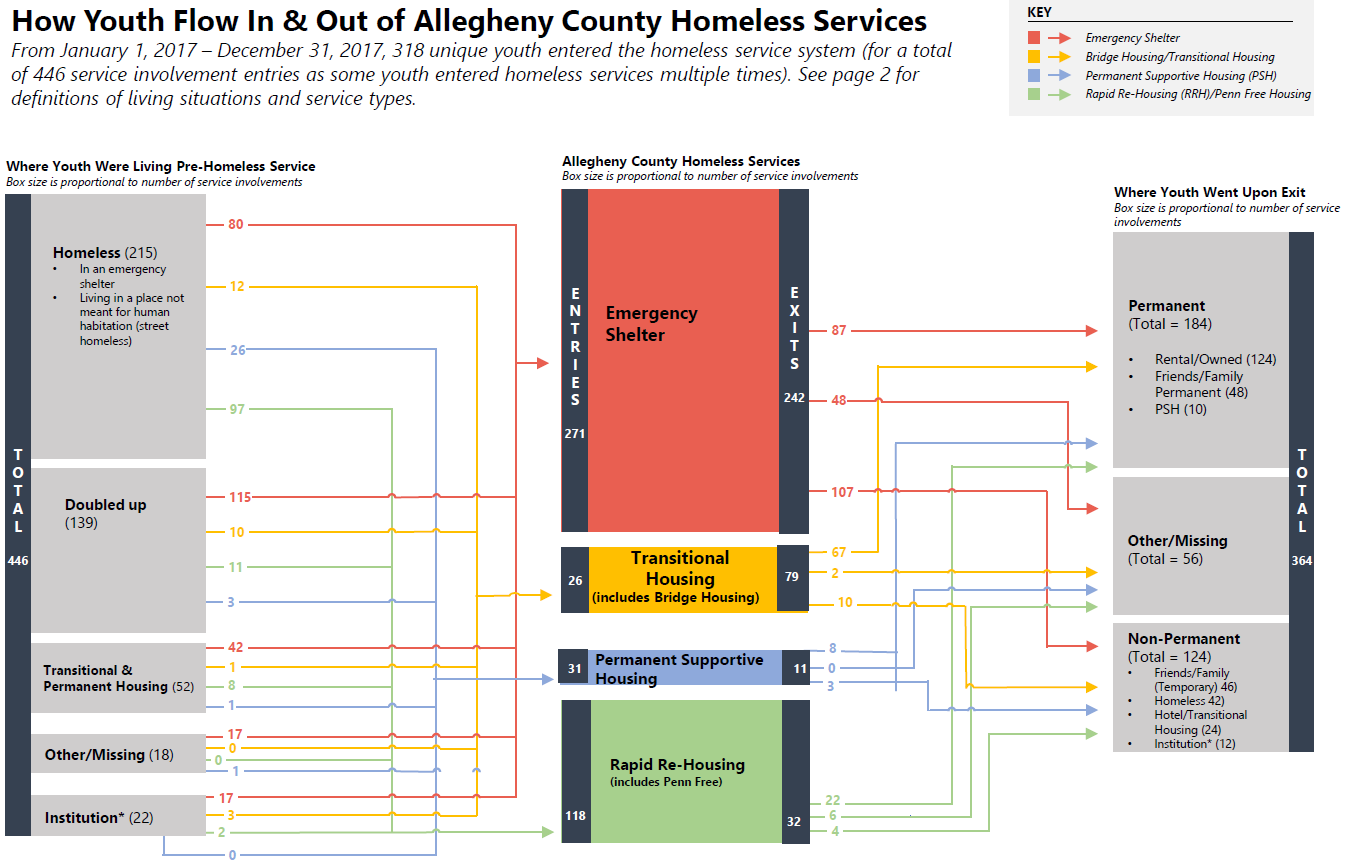The Allegheny County Consumer Action Response Team (CART) gathers feedback from consumers of publicly-funded behavioral health services, which include mental health services and drug and alcohol treatment for adults, children and families. CART conducts face-to-face or telephone interviews with service recipients and their families and summarizes the feedback so that it can be used for quality improvement by the Department of Human Services and its treatment providers. The annual reports below highlight significant trends and findings as collected by CART during its interviews.

This infographic depicts the flow of homeless youth in and out of Allegheny County’s homeless service system in 2017. Analyzing the housing services that youth used — in addition to the places they were residing before and after receiving these services — helps inform outreach efforts and service planning. This is part of an effort to prevent and divert youth from homelessness and improve the housing outcomes of youth who do experience homelessness.
Using data from the County’s Homeless Management Information System (HMIS), 318 youth ages 18-24 who used a homeless service between January 1, 2017 and December 31, 2017 were identified. Residence before and after service utilization were self-reported by youth. Some youth entered the homeless system multiple times during this period for a total of 446 service involvement entries during the period of study. Not all youth who entered a homeless service in 2017 exited within the same year; as a result, total entries into service do not equal exits.
The left side of the chart shows where youth were residing prior to their use of homeless services. The most frequent location was in an emergency shelter or on the street (i.e., in a place not meant for habitation). The middle of the chart displays the homeless services used by youth; emergency shelters were accessed most frequently followed by transitional housing services. The right side of the chart displays where youth went after leaving a homeless service. Most youth went to permanent living situations, though many also went to non-permanent locations and data was not available for about a quarter of service exits.
Click here to view the infographic for 2017.
An infographic about services used by homeless youth in 2016 is available here.

In Allegheny County in 2016, 73 children in child welfare out-of-home placements ran away. This represents three percent of all children and nine percent of children ages 12 through 18 who were in placement that year. In this data brief, we analyze the factors that may contribute to runaway episodes in Allegheny County’s child welfare system such as demographics of the children and their placement types prior to running away.
Approximately 40 percent of the families headed by single mothers in Allegheny County are living below the poverty line, while only four percent of two-parent families are living in poverty. This data brief takes a closer look at families in the region led by single mothers, describes how they fare in comparison to other types of families, and maps where they live in Pittsburgh and Allegheny County.
From 2012 through 2015, 1,255 youth ages 14 through 17 entered into out-of-home placements in Allegheny County. Out-of-home placement settings include foster care, group homes, residential facilities, living with a relative or friend, and supervised independent living. We surveyed 200 of these youth to gain a better understanding of their experiences in the child welfare system. This report includes our key findings and an exploration of respondents’ ideas about how their experiences with the child welfare system could be improved. We will use the results to guide future planning and program development.
The Allegheny County Department of Human Services (DHS), in partnership with the United Way of Southwestern Pennsylvania, has been offering free tax preparation in several locations throughout the County since 2011. Thirteen trained volunteers helped 343 clients in need prepare returns last year. Collectively, these clients received a total federal refund of $519,645, at no cost to them. This brief includes demographic information about the taxpayers who received DHS tax assistance services and the overall results of the 2017 program.
An involuntary commitment, also known as a 302, may occur when an individual is exhibiting symptoms of mental illness that are unmanageable and may result in danger to themselves or to others. The dashboard below displays data about the involuntary commitment process in Allegheny County from petition to examination to inpatient admission. Data ranges from May 2014 to the present and is updated daily.
A related report is also available.
Trouble viewing the dashboard? You can view it directly here.
Related materials
- Report: Involuntary Commitment in Allegheny County, 2002-2013 data

This data brief includes information on involuntary termination of parental rights cases and adoptions handled through CYF. TPR petitions and completed adoption data from 2014-2021 were examined in two separate briefs (linked below).
Click here to read the Adoption and Termination of Parental Rights Brief – 2018-2021
Click here to read the Adoptions and Involuntary Termination Brief – 2014-2017.
The Allegheny County Jail Collaborative is a group of government agencies, nonprofit organizations, volunteers and community members who are committed to improving the transition of people returning to the community after leaving the Allegheny County Jail. This report describes the Jail Collaborative’s 2016-2019 strategic plan, progress that has been made in the past year and advancements expected in the coming years.
This infographic depicts the flow of homeless youth in and out of Allegheny County’s homeless service system. Analyzing the housing services that youth used — in addition to the places they were residing before and after receiving these services — helps inform outreach efforts and service planning. This is part of an effort to prevent and divert youth from homelessness and improve the housing outcomes of youth who do experience homelessness.
Using data from the County’s Homeless Management Information System (HMIS), 260 youth ages 18-24 who used a homeless service between January 1, 2016 and December 31, 2016 were identified. Residence before and after service utilization were self-reported by youth. Some youth entered the homeless system multiple times during this period for a total of 321 service involvement entries during the period of study. Not all youth who entered a homeless service in 2016 exited within the same year; as a result, total entries into service do not equal exits.
The left side of the chart shows where youth were residing prior to their use of homeless services. The most frequent location was a doubled-up situation, i.e., living with a friend or family member in a place where they could not stay permanently. The middle of the chart displays the homeless services used by youth; emergency shelters were accessed most frequently followed by transitional housing services. The right side of the chart displays where youth went after leaving a homeless service. Most youth went to permanent living situations, though many also went to non-permanent locations and data was not available for about a quarter of service exits.
A total of 20,190 children were referred to the child welfare system in Allegheny County due to abuse or neglect in 2015. The data in this brief analyzes the number and rate of children of different races at four critical stages within the child welfare system: referral, investigation, accept for service and home removal. While this analysis does not identify the reason for the disproportionality that exists, it is clear there is unequal representation of black and bi/multiracial children within the child welfare system as compared to the representation of these groups in Allegheny County.
The Allegheny County YOUth Count survey was initiated in 2015 to gain a more accurate count of youth experiencing housing instability. Data gathered was meant to enhance yearly HUD-required Point-in-Time (PIT) homelessness counts to determine how best to connect this population with the services they need. This data brief outlines key findings of the 2016 survey and explains the County’s ultimate decision to conduct two PIT counts next year and enlist the help of youth-serving providers to collect data rather than designing a separate survey.
Eleven Allegheny County foster care provider agencies formed a training cooperative in order to improve the number and quality of training opportunities for foster parents. After increasing the number and variety of trainings, the cooperative requested feedback to inform quality and access improvements. DHS staff conducted telephone surveys with foster parents and identified a number of recommendations for improvement. This brief provides an overview of the survey process and findings.
Conferencing and Teaming is the Allegheny County Department of Human Services’ practice model designed to engage child welfare participants, and their natural supports, in a process of family strengthening through client-driven goal setting and achievement. An analysis of participant experiences with Conferencing and Teaming was conducted in order to assess their satisfaction with the process and ways in which participation might be improved. The analysis was based on telephone surveys with more than 200 participants. Findings from the analysis and resulting recommendations are described in this brief.


